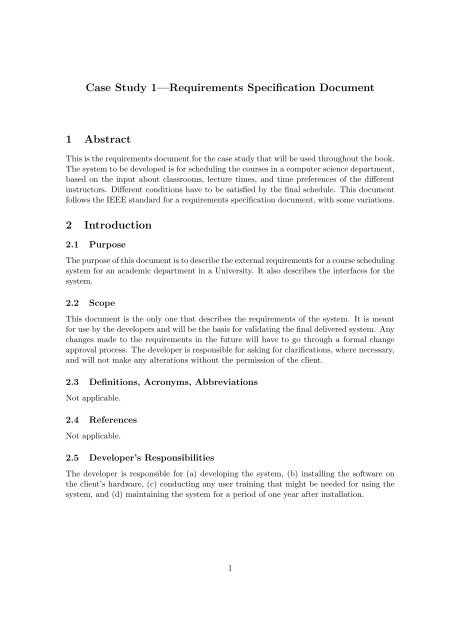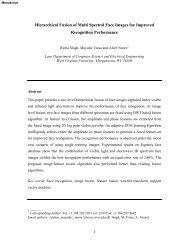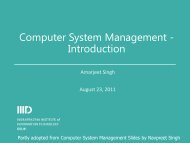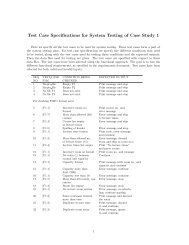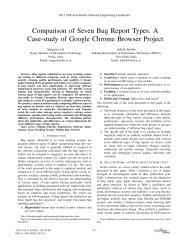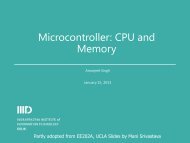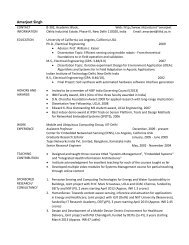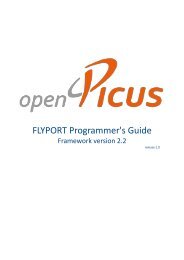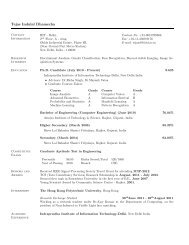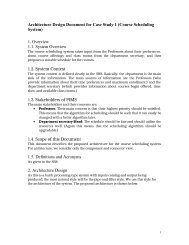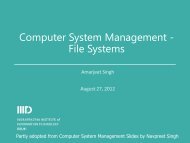Case Study 1âRequirements Specification Document 1 ... - IIIT
Case Study 1âRequirements Specification Document 1 ... - IIIT
Case Study 1âRequirements Specification Document 1 ... - IIIT
- No tags were found...
You also want an ePaper? Increase the reach of your titles
YUMPU automatically turns print PDFs into web optimized ePapers that Google loves.
<strong>Case</strong> <strong>Study</strong> 1—Requirements <strong>Specification</strong> <strong>Document</strong>1 AbstractThis is the requirements document for the case study that will be used throughout the book.The system to be developed is for scheduling the courses in a computer science department,based on the input about classrooms, lecture times, and time preferences of the differentinstructors. Different conditions have to be satisfied by the final schedule. This documentfollows the IEEE standard for a requirements specification document, with some variations.2 Introduction2.1 PurposeThe purpose of this document is to describe the external requirements for a course schedulingsystem for an academic department in a University. It also describes the interfaces for thesystem.2.2 ScopeThis document is the only one that describes the requirements of the system. It is meantfor use by the developers and will be the basis for validating the final delivered system. Anychanges made to the requirements in the future will have to go through a formal changeapproval process. The developer is responsible for asking for clarifications, where necessary,and will not make any alterations without the permission of the client.2.3 Definitions, Acronyms, AbbreviationsNot applicable.2.4 ReferencesNot applicable.2.5 Developer’s ResponsibilitiesThe developer is responsible for (a) developing the system, (b) installing the software onthe client’s hardware, (c) conducting any user training that might be needed for using thesystem, and (d) maintaining the system for a period of one year after installation.1
3 General Description3.1 Product Functions OverviewIn the computer science department there are a set of classrooms. Every semester thedepartment offers courses, which are chosen from the set of department courses. A coursehas expected enrollment and could be for graduate students or undergraduate students. Foreach course, the instructor gives some time preferences for lectures.The system is to produce a schedule for the department that specifies the time and roomassignments for the different courses. Preference should be given to graduate courses, andno two graduate courses should be scheduled at the same time. If some courses cannot bescheduled, the system should produce a “conflict report” that lists the courses that cannotbe scheduled and the reasons for the inability to schedule them.3.2 User CharacteristicsThe main users of this system will be department secretaries, who are somewhat literatewith computers and can use programs such as editors and text processors.3.3 General ConstraintsThe system should run on Sun 3/50 workstations running UNIX 4.2 BSD.3.4 General Assumptions and DependenciesNot applicable.4 Specific Requirements4.1 Inputs and OutputsThe system has two file inputs and produces three types of outputs.Input file 1: Contains the list of room numbers and their capacity; a list of all the coursesin the department catalog; and the list of valid lecture times. The format of the file is:roomsroom1 : cap1room2 : cap2:;coursescourse1 , course2 , course3 , .... ;timestime1 , time2 , time3 ;2
where room1 and room2 are room numbers with three digits, with a maximum of 20 roomsin the building; cap1 and cap2 are room capacities within the range [10, 300]; course1,course2 are course numbers, which are of the form “csddd,” where d is a digit. There areno more than 30 courses. time1 and time2 are valid lecture times of the form “MWFd” or“MWFdd” or “TTd” or “TTd:dd” or “TTdd:dd”. There are no more than 15 such validlecture times. An example of this file is:rooms101 : 25115 : 50200 : 250 ;coursescs101, cs102, cs110, cs120, cs220, cs412, cs430, cs612, cs630 ;timesMWF9, MWF10, MWF11, MWF2, TT9, TT10:30, TT2, TT3:30 ;Input file 2: Contains information about the courses being offered. For each course, itspecifies the course number, expected enrollment, and a number of lecture time preferences.A course number greater than 600 is a post-graduate course; the rest are undergraduatecourses. The format of this file is:course enrollment preferencesc#1 cap1 pre1 , pre2 , pre3 ...c#2 cap2 pre1 , pre2 , pre3 ...::where c#1 and c#2 are valid course numbers; cap1 and cap2 are integers in the range[3..250]; and pre1, pre2, and pre3 are time preferences of the instructor (a maximum of 5preferences are allowed for a course). An example of this file iscourse enrollment preferencescs101 180 MWF9, MWF10, MWF11, TT9cs412 80 MWF9, TT9, TT10:30cs612 35cs630 40Output 1: The schedule specifying the class number and time of all the schedulable courses.The schedule should be a table having the lecture times on the x-axis and classroom numberson the y-axis. For each slot (i.e., lecture time, classroom) the course scheduled for it is given;if no course is scheduled the slot should be blank.Output 2: List of courses that could not be scheduled and why. For each preference, thereason for inability to schedule should be stated. An example is:cs612: Preference 1: Conflict with cs600.Preference 2: No room with proper capacity.3
Output 3: Error messages. At the minimum, the following error messages are to be given:e1. Input file does not exist.e2. Input-file-1 has errore2.1. The course number has wrong formate2.2. Some lecture time has wrong format.e2.3. Classroom number has wrong format.e2.4. Classroom capacity out of range.e3. Input-file-2 has errore3.1. No course of this number.e3.2. No such lecture time.e4. More than permissible courses in the file; later ones ignored.e5. There are more than permissible preferences.Later ones are ignored.4.2 Functional Requirements1. Determine the time and room number for the courses such that the following constraintsare satisfied:(a) No more than one course should be scheduled at the same time in the same room.(b) The classroom capacity should be more than the expected enrollment of thecourse.(c) Preference is given to post-graduate courses over undergraduate courses forscheduling.(d) The post-graduate (undergraduate) courses should be scheduled in the order theyappear in the input file, and the highest possible priority of an instructor shouldbe given. If no priority is specified, any class and time can be assigned. If anypriority is incorrect, it is to be discarded.(e) No two post-graduate courses should be scheduled at the same time.(f) If no preference is specified for a course, the course should be scheduled in anymanner that does not violate these constraints.Inputs: Input file 1 and Input file 2.Outputs: Schedule.2. Produce a list of all courses that could not be scheduled because some constraint(s)could not be satisfied and give reasons for unschedulability.Inputs: Input file 1, and Input file 2.Outputs: Output 2, i.e., list of unschedulable courses and preferences and why.3. The data in input file 2 should be checked for validity against the data provided ininput file 1. Where possible, the validity of the data in input file 1 should also bechecked. Messages should be given for improper input data, and the invalid data itemshould be ignored.4
Inputs: Input file 1 and Input file 2.Outputs: Error messages.4.3 External Interface RequirementsUser Interface: Only one user command is required. The file names can be specified inthe command line itself or the system should prompt for the input file names.4.4 Performance ConstraintsFor input file 2 containing 20 courses and up to 5 preferences for each course, the reportsshould be printed in less than 1 minute.4.5 Design ConstraintsSoftware ConstraintsThe system is to run under the UNIX operating system.Hardware ConstraintsThe system will run on a Sun workstation with 256 MB RAM, running UNIX. It will beconnected to an 8-page-per-minute printer.Acceptance CriteriaBefore accepting the system, the developer must demonstrate that the system works on thecourse data for the last 4 semesters. The developer will have to show through test casesthat all conditions are satisfied.5


